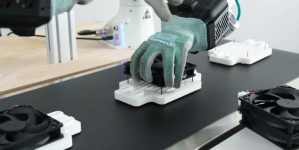-
AI startup Onton raises $7.5M to reinvent the way the world discovers and decides what to buy - November 26, 2025
-
Forklift Market Positions for Recovery as Confidence Expected to Build from 2026 - November 26, 2025
-
PROCare achieves 300% order capacity increase and 99% picking accuracy with Forterro’s ERP solution, Orderwise - November 26, 2025
-
DHL boosts operational efficiency and customer communications with HappyRobot’s AI Agents - November 25, 2025
-
STENA LINE TEAMS UP WITH CAMERA TELEMATICS TO DRIVE SAFETY IMPROVEMENTS AT IRISH SEA PORTS - November 25, 2025
-
Another design award for Toyota’s lithium-ion Traigo_i counterbalanced forklift - November 21, 2025
-
Stuut Technologies Raises $29.5 Million Series A Led by Andreessen Horowitz to Automate Accounts Receivable Work - November 20, 2025
-
INCREASED DIGITAL INVESTMENT REQUIRED TO KEEP PACE WITH 2026 CUSTOMS CHANGES - November 19, 2025
-
FULFILMENT SOLUTIONS FOR SPORTS MERCHANDISE: KEEPING OUR EYE ON THE GAME - November 19, 2025
-
COMPLEX, COSTLY & CONFUSING – THE END OF DE MINIMIS - November 19, 2025
Health & Safety, the key to a productive warehouse
On average, more than 4.5 million working days are lost as a result of work place accidents every year. James Smith, co-owner of A-SAFE, the international safety barrier manufacturer and inventor of the world’s leading polymer safety barriers, offers his insights into the increasing importance of warehouse health and safety and its impact on productivity.
“Warehouses can be dangerous places to work, so it’s imperative that health and safety standards are up to scratch. The nature of a warehouse environment means there is always a high level of both pedestrian and vehicle traffic, making for numerous unforeseen hazards.
“Unfortunately vehicular accidents are very common in the warehouse and logistics industry. Worldwide there are more than 400 deaths or serious injuries as a result of forklift truck collisions in the workplace each year. They may be common, however, many are avoidable.
“Warehouse vehicles, like forklift trucks, are the cause of a large number of injuries, but other incidents such as falls and slips are also to blame for accidents that can damage warehouse productivity.
“Productivity is a big priority for warehouse and logistics managers everywhere, and safety plays a big role in ensuring output levels don’t drop. Minimising the risk of slips, trips, equipment accidents and collisions between people and vehicles creates fewer workplace disruptions, reduces absences resulting from injuries and limits equipment downtime.
“Here are four points to be aware of, to ensure your warehouse productivity won’t suffer at the hands of health and safety mishaps:
1. Slips, trips and falls are commonplace in warehouse environments and account for a 40% of all reported major workplace injuries[1]. They are, however, easily avoidable. Employers have a duty to assess risks associated with slips and trips, and, where necessary, take steps to address them. Usually, simple measures such as clearing up spillages and keeping walkways clear, with no trailing wires or contamination, are enough to significantly reduce the hazard. Using barriers to outline designated pedestrian routes also stops employees wandering into unauthorised areas and slipping as a result. Looking at the bigger picture, damaged or worn flooring needs to be monitored, along with other considerations such as non-slip cleaning products and footwear choices.
2. In the UK, forklift trucks are involved in around a quarter of all workplace accidents[2], so enforcing a speed limit and ensuring employees understand the potential hazards of using this equipment will help to reduce this risk. Forklifts, and other vehicles such as pedestrian operated pallet trucks and trolleys, can also cause significant injury to warehouse personnel should they be hit by these moving objects. This again reinforces the need for warehouses, and similar environments, to have designated routes for pedestrian and vehicle traffic, to minimise the risk of injury or potentially fatal accidents.
Racking is also particularly vulnerable to impacts from vehicles, such as forklift trucks, therefore those responsible for driving vehicles at work need to take extra care when doing so in a busy warehouse. Products such as RackEye can help warehouse managers identify rack damage as soon as it occurs, and take immediate remedial action to maintain safety. This avoids unnecessary downtime and could prevent potentially disastrous consequences. The rack safety detection system also helps to improve driver care by making warehouse vehicle drivers more accountable should an impact occur.
3. Most warehouses store items at a height, however being struck by a moving, including falling/flying, object accounts for 10% of all non-fatal workplace injuries[3]. To minimise this risk, ensure racks are stacked neatly and evenly, with heavier items as close to the ground as possible. It’s also imperative that pallets are inspected before use to reduce the risk of loads shifting and causing damage. Installing high-level barriers with a roof over pedestrian walkways dramatically reduces the risk of injury from this type of hazard.
4. Regular safety briefings will naturally get warehouse employees thinking about health and safety and encourage them to identify potential hazards. Last year around 64% of those who witnessed unsafe practices and did not report them were managers or supervisors[4] which demonstrates a wider knowledge of the need for strict health and safety procedures in warehouses is required.
“This advice may sound simple, but increasing awareness of these issues is a great way to limit health and safety related incidents and the associated drop in productivity.” www.asafe.com
[1] http://www.hse.gov.uk/pubns/indg225.pdf
[2] http://www.hse.gov.uk/workplacetransport/lift-trucks/managing-lift-trucks.htm
[3] According to Reporting of Injuries, Diseases and Dangerous Occurrences Regulations (RIDDOR) – http://www.hse.gov.uk/Statistics/tables/index.htm#riddor
[4] http://fork-truck.org.uk/discover-amp-join/news/flta-launches-safetember-initiative-throughout-september

































